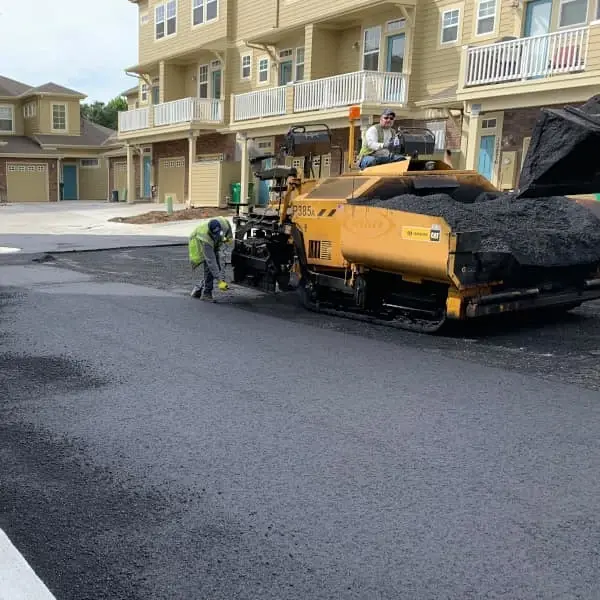Asphalt
Originally a naturally occurring product in use for centuries the early 1900’s brought today’s refined petroleum product. This term is often applied to almost any asphalt product from H.M.A.C. to asphalt cements and oils.
Asphalt Cement
A dark brown to black cementitious material in which the predominating constituents are bitumens which occur in nature or are obtained in petroleum processing. In varying proportions, asphalt is a constituent of most crude petroleums.
Base
Generic term for material installed prior to asphalt paving. May be a crushed stone product or asphalt product (see full-depth asphalt pavements). The base material provides the load bearing characteristics of the finished pavement and may vary from 3-4″ for a residential driveway to 18″ or more for parking areas or roadways. The correct type and amount of base material must be determined and specified prior to paving. Lack of adequate base material is a primary cause of pavement failures.
Blacktop
Common “slang” term for asphalt. However this term should not be used in requesting any specifications or work as the term is widely used with various meanings in different areas. For example sometimes “blacktop” is used to refer to a penetration pavement or hot oil treatment (see fog seal).
Course, Asphalt Base
A foundation course consisting of mineral aggregate, bound together with asphalt material.
Course, Asphalt Surface
The top course of an asphalt pavement, sometimes called asphalt wearing course.
Emulsion
Mechanically produced combination of ingredients which do not normally mix. For example, asphalt emulsions are made by a procedure which mechanically mills the warm asphalt into minute globules, dispersing them in water, and adding a small amount of an emulsifying agent.
Fog Seal
A process of applying a highly diluted asphalt emulsion in a fine spray (fog) to a roadway surface. Restores blackness and seals hairline cracks, may prevent or slow oxidation. Not generally used for parking facilities due to tracking.
Full-Depth Asphalt Pavement
The process of constructing an asphalt pavement structure using asphalt products for all components. The base material and surface courses are all made up of appropriately specified grades of hot-mix asphalt in contrast to conventional paving using crushed stone materials etc. There are numerous benefits to this method of construction. The Asphalt Institute has excellent detailed information about this process.
H.M.A.C. Hot Mix Asphalt Concrete
Abbreviation of the proper name for what is commonly referred to as “asphalt”, “hot-mix”, “blacktop” etc. This term should always be used in specifying asphalt pavement work to avoid any confusion or misinterpretation of the material desired. H.M.A.C. is produced in many different grades from coarse base mixes to specialized mixes for surfacing and repair. In most instances the grades are specified according to state department of transportation guidelines.
Laydown
The portion of the asphalt paving process where the hot asphalt is actually placed or “laid down” by the paving machine.
Mat, Asphalt
A term used to describe the fresh asphalt surface behind the paving machine. Most commonly used to refer to the asphalt during the laydown and compaction phase of construction.
Prime Coat
A coating of asphalt oil either cutback or specialized emulsion, used to seal the sub-base and/or base material and enhance bonding to the asphalt course.
Reflective Cracking
Cracks in an asphalt overlay pavement caused by cracks in the existing pavement “reflecting” up through the overlay. Specialized techniques and materials such a multi-membrane paving fabrics help reduce this problem.
Routing
Enlargement of pavement cracks using a specialized machine. This provides a uniform width reservoir for the sealant. Proper choice of bit size will result in the proper depth to width ratio (depth=width). Properly used this procedure greatly increases the effectiveness and durability of crack sealing.
Sealcoating
Application of a sealant (usually coal-tar emulsion or asphalt emulsion type) to preserve, protect, and beautify asphalt pavements. Generally used on low traffic streets or off-street locations. There are many different sealcoating products available from low-end “do-it-yourself” grades sold in buckets to commercial products. Commercial products are sold in bulk in concentrated form. Water, silica sand (or other suitable aggregates) and specialized additives are then added in precise ratios (mix design) by the contractor in an agitated mixing tank. Care should be taken to choose the appropriate product, mix design, and application method for the specific project and it’s location.
Slurry Seal
A sealcoating process generally used on runways, streets, and roadways. In this process the coating is manufactured by the application equipment as it is being applied. A closely specified blend of graded asphalt emulsion, additives, and aggregate slurry seal is generally classified as Type I, II, or III depending on the size of aggregate used. A large aggregate slurry seal with additional polymers may also be referred to as micro surfacing. Used infrequently on parking areas due to the potential for tracking in hot weather.
Subgrade
The soil prepared to support a structure or a pavement system. It is the foundation for the “pavement structure.”
Tack Coat
Asphalt oil, usually emulsion type, applied to existing pavement during repairs or overlay paving to create a bond between the old and new asphalt.


